Survey: The rise of smart homes

Key takeaways
- 77% of respondents had a positive sentiment toward smart homes
- 69.1% of respondents reported owning at least one smart home device/appliance
- 60.2% of respondents believed that the brand of a smart home device/appliance matters
- The average number of smart home devices/appliances respondents plan to buy in 2021 is 1.4
Once upon a time, the "future" of smart home technology might have made you think of futuristic cartoons. Parking your flying car, using a robot maid to help clean around the house and appliances you could command with a single button click. And while there might not be a flying car parked in your garage (at least not yet), smart home technology exists in more facets of everyday life than ever before.
Expected to grow another 57% over the next five years, as many as 80 million U.S. homes had plans to purchase some kind of smart home technology in 2020. From voice-activated TVs and doorbells that connect to a phone to kitchen appliances you can control with your voice and even toilets and bathtubs with smart sensors, smart home technology is here to stay.
With so many options and a wide range of price points and features, you might not know where to start in expanding the smart home functionality of your house or apartment. For a closer look at how much money people are spending on smart home tech and which brands they trust, we surveyed over 1,000 people about their most recent purchases in this space. Read on as we break down how smart home adoption can change based on age, which features people are most excited about, what might have them concerned and which products are at the top of their smart home wish lists.
Eagerly adopting smart home tech
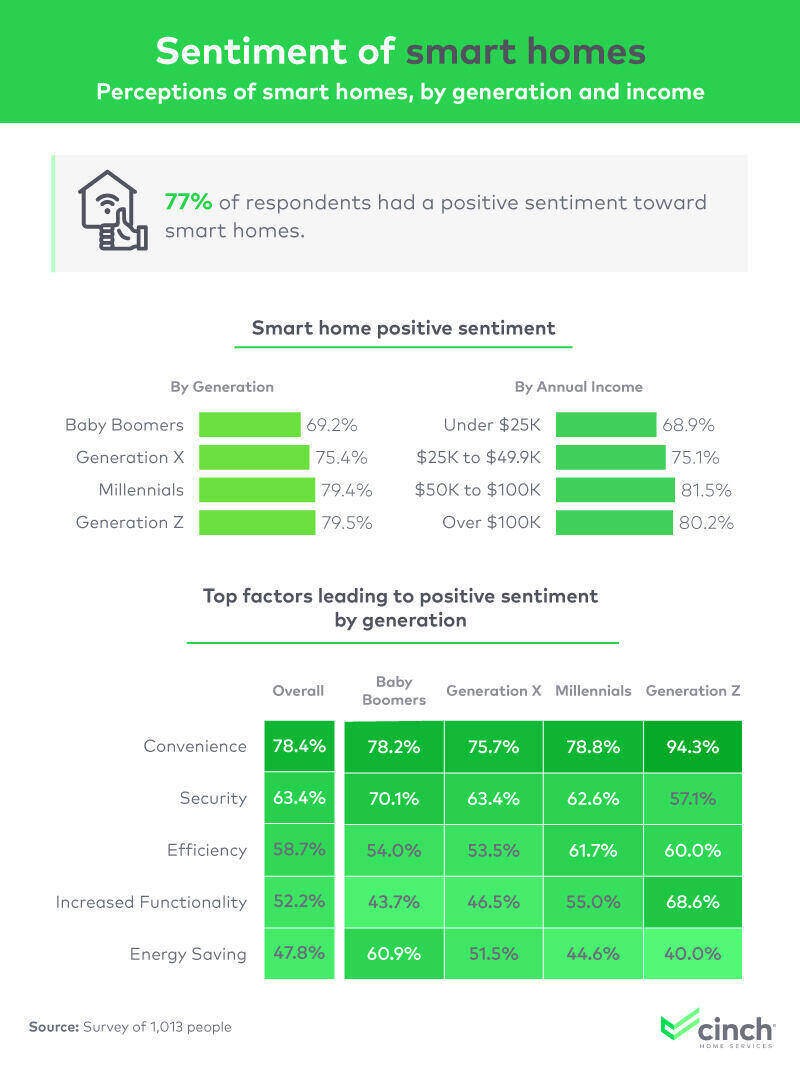
Overwhelmingly, 77% of people surveyed had a positive sentiment toward smart home technology. Compared to 69% of baby boomers, millennials (79%) and Generation Z (80%) users were the most likely to report a positive opinion on adopting smart home tech. As we found, positive sentiment also increased among people with a higher average annual salary, rising from 69% among those earning under $25,000 to 82% among those earning between $50,000 and $100,000.
There are many reasons why users might choose to automate or advance their homes, ranging from centralizing control over their existing technology, going green on energy consumption, or looking to beef up their security. Among those polled, a positive attitude toward smart home technology was attributed to the convenience offered by those products (78%), followed by security (63%) and efficiency (59%).
Generation Z respondents were the most likely to value convenience offered by smart home products (94%) but the least likely to have a positive perception based on security features or benefits (57%). Although baby boomers might have the lowest affirming position on bringing smart tech into their homes, they were the most likely to be impressed by security features (70%) or energy-saving benefits (61%).
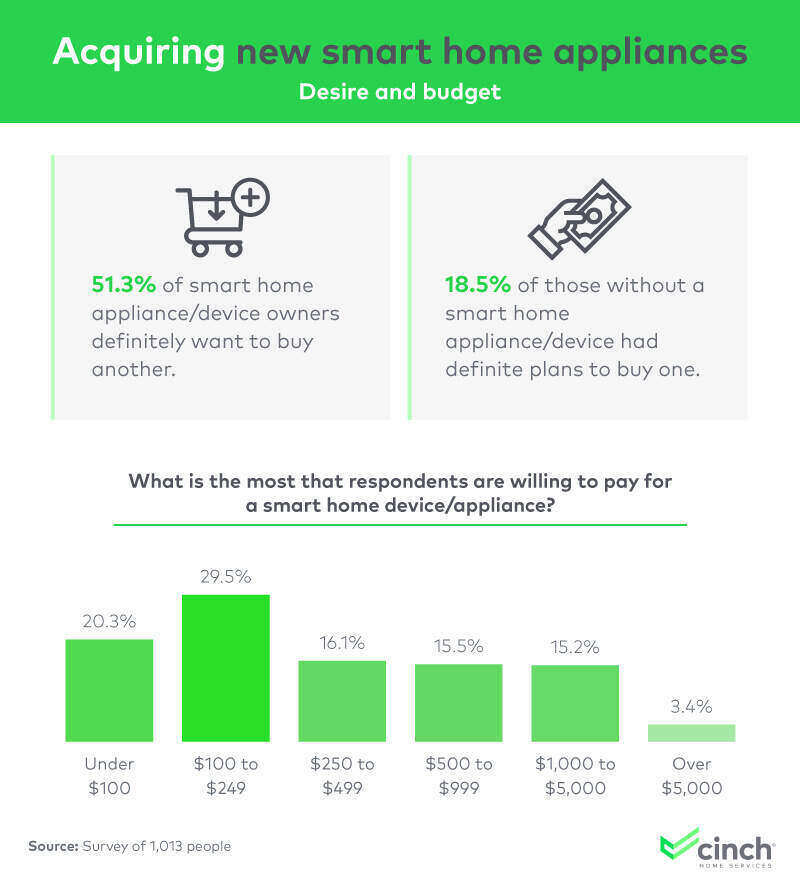
More than half of smart home appliance or device owners said they wanted to buy another, and 19% of people who didn't own any smart home technology said they had definite plans to purchase it in the future.
And just how much are they willing to pay? Thirty percent of people said they would spend between $100 and $249 for a smart device or appliance, though 16% were willing to spend between $500 and $999, and another 15% were willing to spend between $1,000 and $5,000. While smaller overall, 3% of respondents were willing to pay more than $5,000 to bring smart technology into their homes.
Trusted tech brands and devices
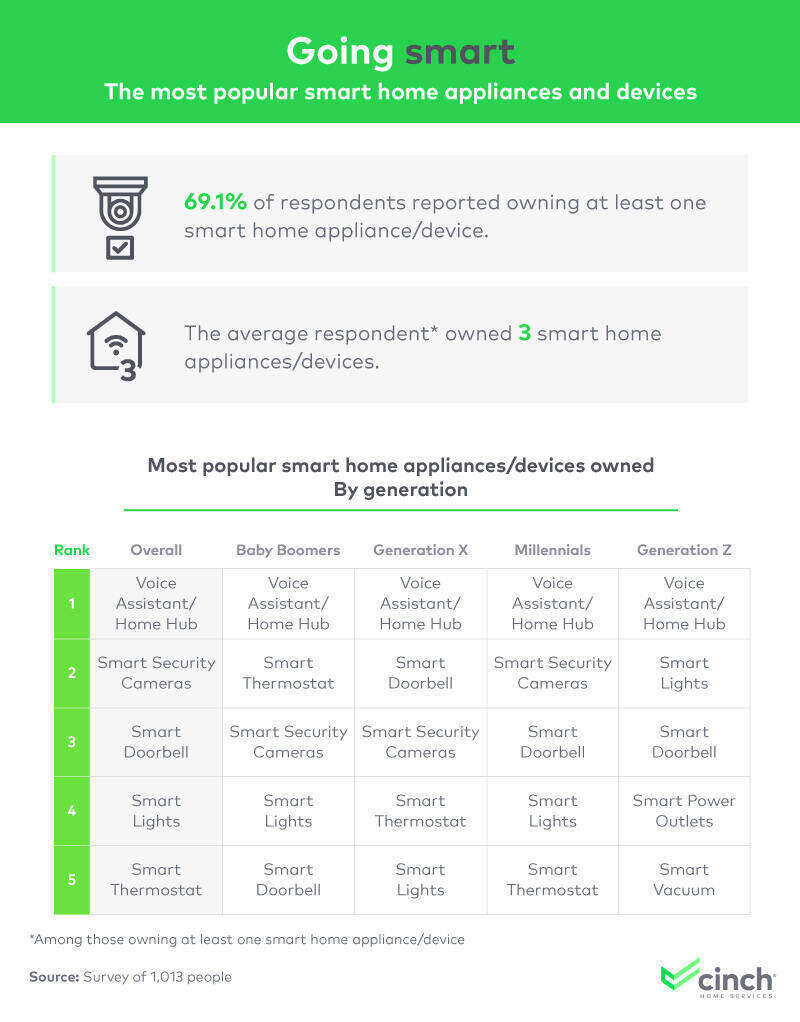
Sixty-nine percent of people we polled indicated owning at least one smart home appliance or device, and among those who had already adopted smart home tech, the average ownership was 2.7 appliances or devices.
Across the board, regardless of age, the most commonly owned piece of smart home technology was a voice assistant or home hub. With prices ranging from under $50 to over $400 and a range of features to pick from, including surround sound or video functionality, it's no surprise many consumers gravitate to the voice assistant first. Among Generation Z, we found the next most commonly adopted smart home product was smart lights, though millennials leaned toward smart security cameras, and Generation X respondents were the most likely to own smart doorbells. In contrast, baby boomers were the most likely to own smart thermostats in addition to voice assistant products. Generation Z might be the most willing group to adopt less popular components to a smart home, identifying both smart power outlets and smart vacuums among their most common smart tech purchases.
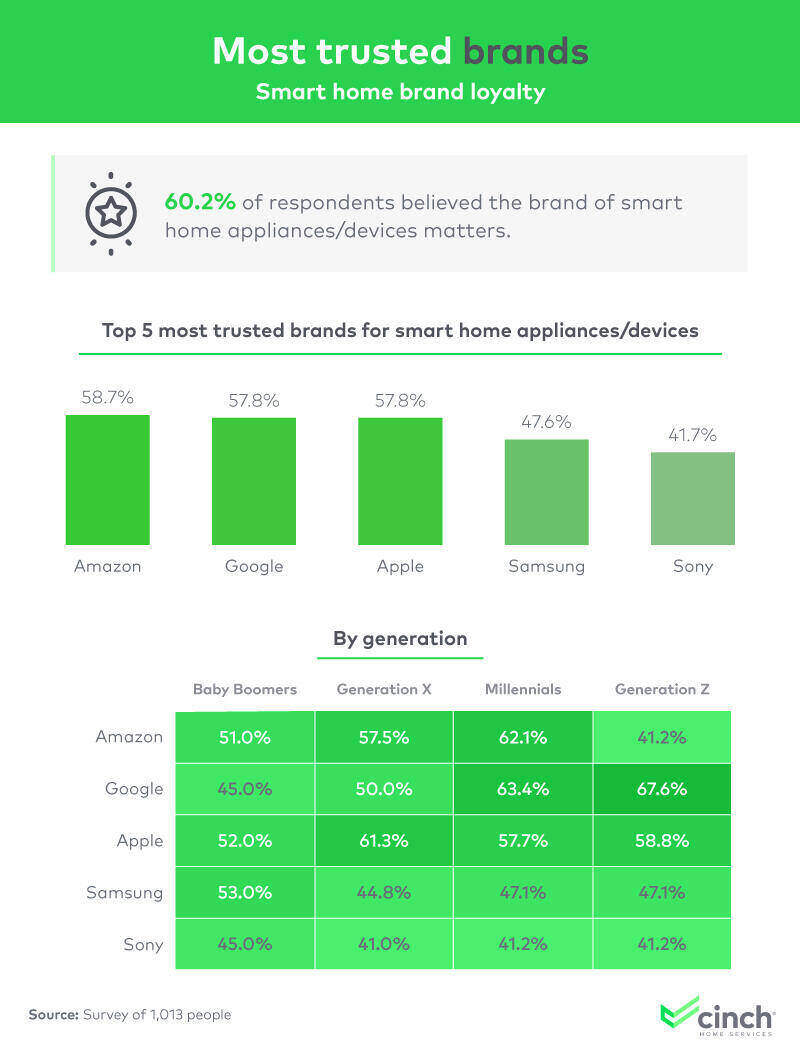
Deciding which smart home accessories or appliances to buy isn't always about the features they offer, or even how they look. In some cases, it can be about the smart home "ecosystem" you've adopted – including Amazon Alexa, Apple's HomeKit, or Google Home – and making sure that any future purchases mesh well with the existing technology in your home. This may also be why a vast majority (97%) of people who already owned a smart speaker only used one platform for their smart tech.
Sixty percent of people polled acknowledged the brand of smart home appliances or devices mattered and indicated they had the highest level of trust in Amazon (59%), followed by Google and Apple (58% each). And while millennials (62%) were the most likely generation to express trust in Amazon's smart home technology, Generation Z respondents (41%) were far less likely to echo this sentiment. Instead, we found Google (68%) was most trusted by Generation Z, and Apple was favored among Generation X (61%). While less common, baby boomers were the most likely generation to report trusting either Samsung (53%) or Sony (45%) smart home products.
Dollars and sense behind smart tech
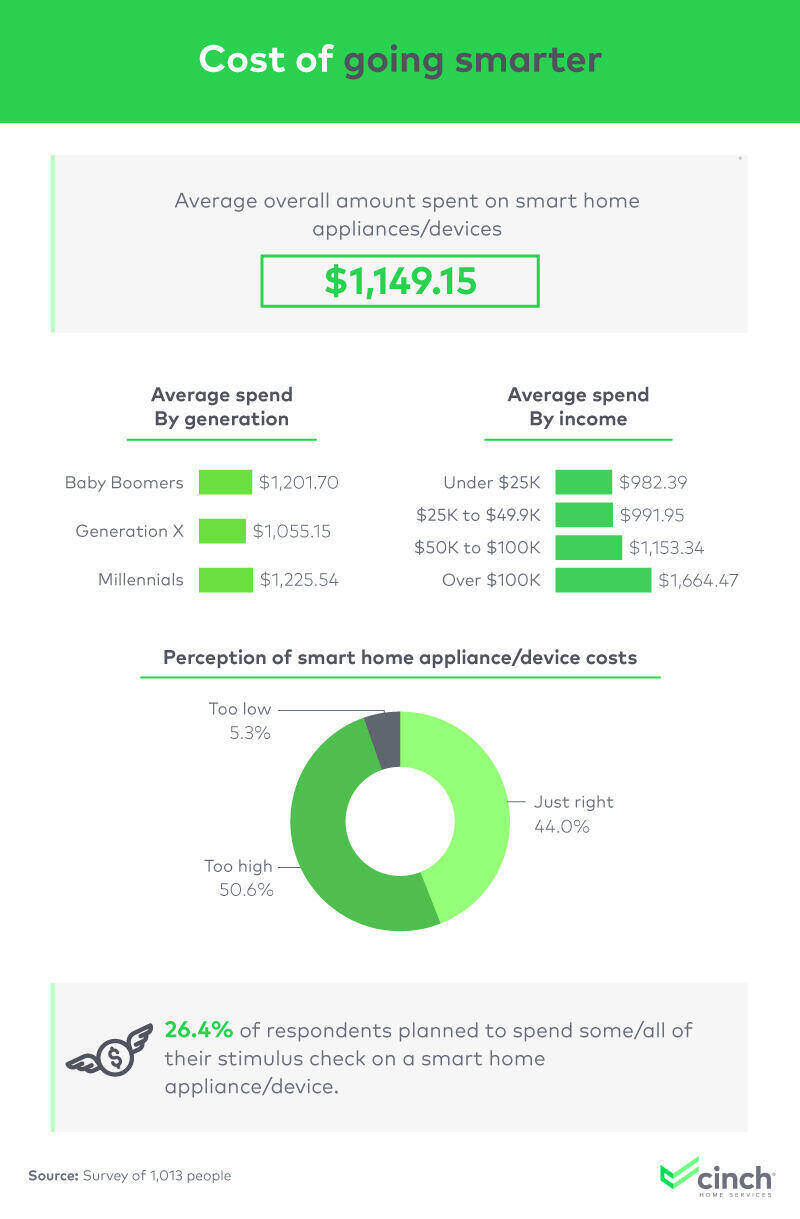
On average, people we surveyed who had already bought into smart home technology owned nearly three different devices or appliances. Respondents reported spending nearly $1,150 on their smart home tech, including millennials (who spent the most) at $1,226 and baby boomers who spent $1,202, on average. People earning over $100,000 a year spent $1,664 on their smart home technology purchases, compared to people earning less than $25,000 who spent $982, on average.
Roughly half (51%) of people agreed the average price of smart home technology was too high, compared to 44% who believed it was priced appropriately and 5% of respondents who said it was too low instead. More than 1 in 4 people acknowledged planning to spend at least some or all of their stimulus money on smart home technology.
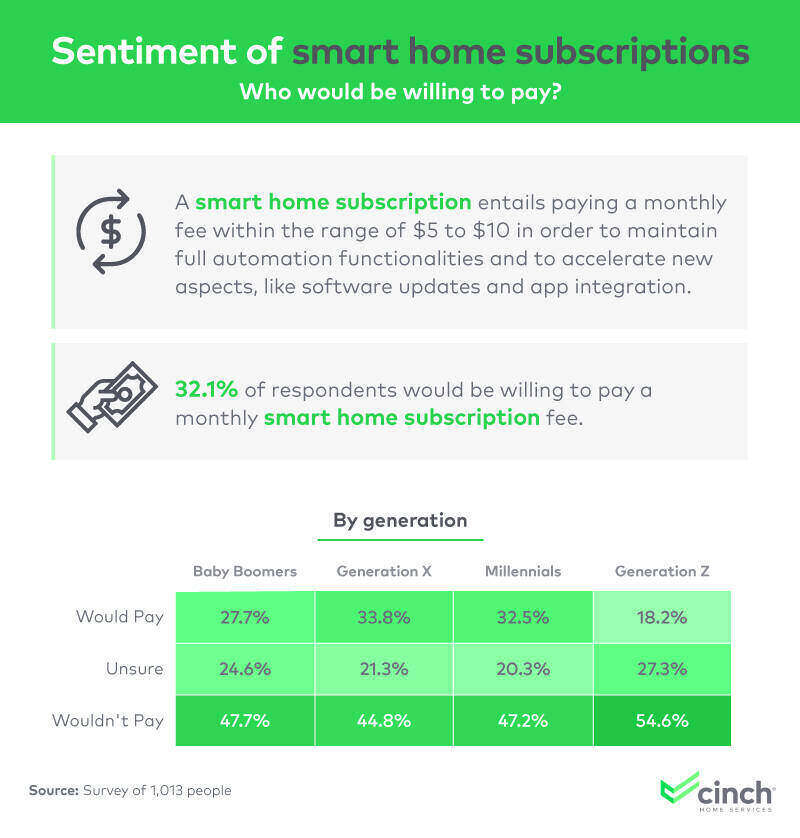
Sometimes, the cost of connectivity doesn't stop at the device. In some cases, smart home technology requires users to pay a monthly fee, often ranging between $5 and $10 a month, to keep their products activated. Nearly a third of respondents said they would be willing to pay a monthly smart home subscription fee. Generation X respondents were the most willing to pay this kind of fee (34%), followed by millennials (33%) and baby boomers (28%). Fifty-five percent of Generation Z respondents said they were unwilling to pay this type of recurring charge in order to keep their smart home technology activated.
Concerned about technology
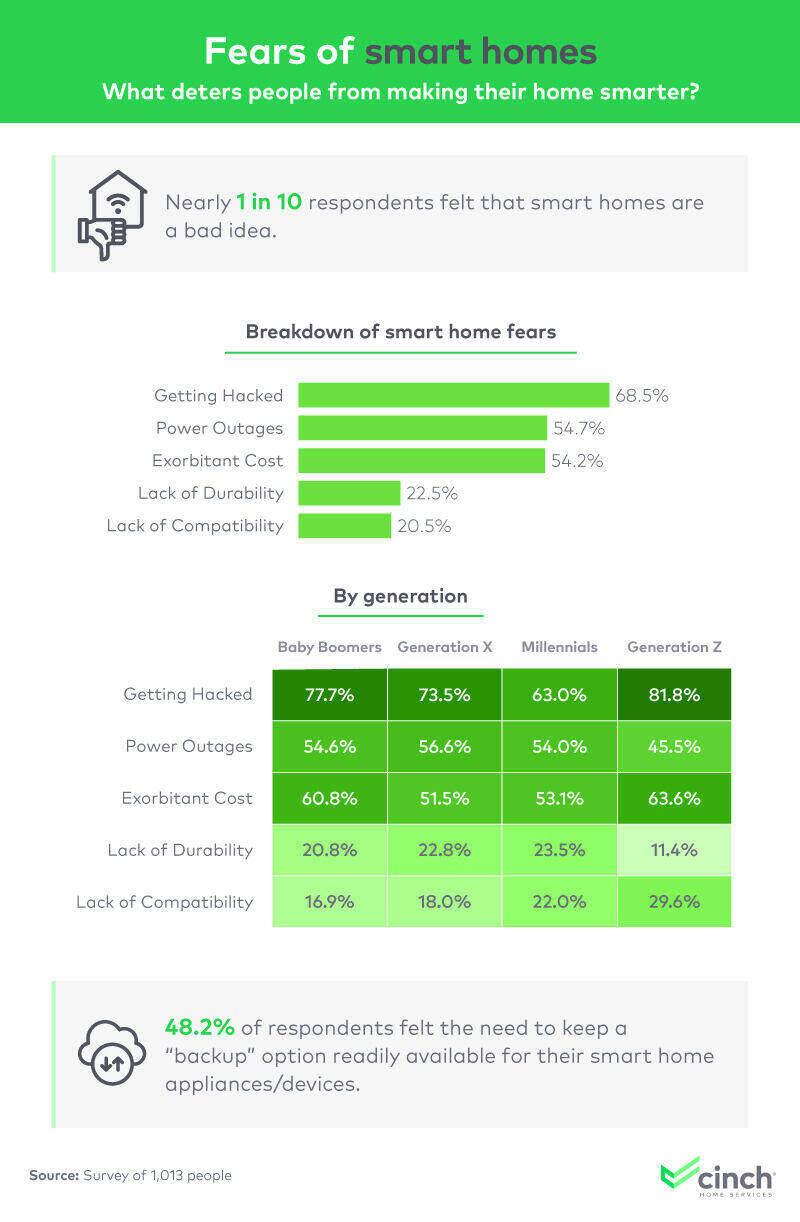
While generally viewed in a positive light, 1 in 10 people polled indicated smart homes were a bad idea. The most common fears around integrating home appliances with smart technology included concerns of being hacked (69%), power outages (55%), and the overall cost (54%). While far less common, 23% of people were concerned smart home tech was less durable, and 21% were afraid these appliances or products wouldn't be compatible with existing wares.
Privacy and protection are important elements to keep in mind when purchasing smart home technology, as the connectivity elements could offer hackers an entry point into your home and digital ecosystem. Generation Z respondents were the most concerned about being hacked (82%), followed by baby boomers (78%) and Gen X respondents (74%). Gen Zers were also the most concerned about compatibility in their homes and the cost of adopting smart tech. In contrast, millennials were the most concerned about the lack of durability, and Gen Xers were the most worried about power outages.
Getting smarter in the future
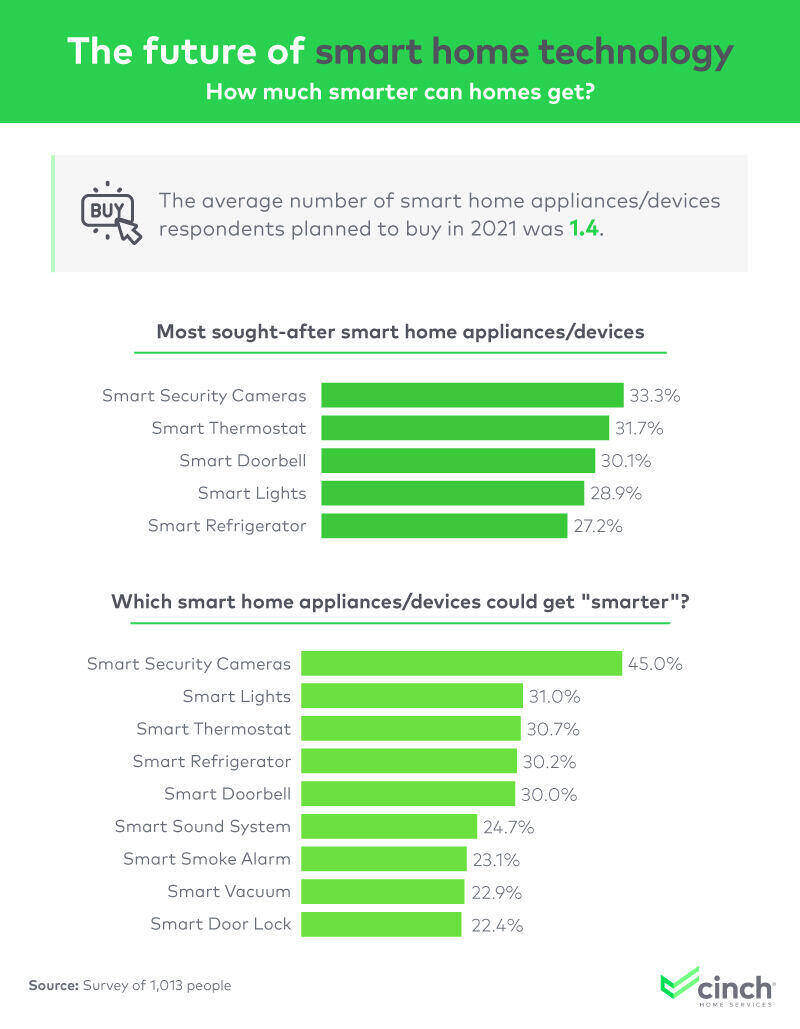
In 2021, respondents reported planning to buy 1.4 new smart home appliances or devices, on average. The most desirable purchases included smart security cameras (33%), smart thermostats (32%), smart doorbells (30%), and smart lights (29%). In thinking about their homes, people acknowledged they wanted to see security cameras get "smarter" in the future (45%), followed by kitchen appliances (33%), lights (31%), and thermostats (nearly 31%).
Respondents were generally less interested in seeing their sound systems (25%), smoke alarms (23%), vacuums (23%), or door locks (22%) advanced with technology.
Protecting your smart purchases
Smart home technology is here to stay, and many people have already adopted it in the form of voice assistants, thermostats, doorbells, security cameras, and lights. Bringing your home into the digital age typically isn't a one-and-done purchase, either. People owned nearly three different smart home devices, on average, and many had plans to buy more. A majority of people were willing to spend hundreds of dollars on a smart home device or appliance and had already spent over $1,000, on average, outfitting their homes.
If you're thinking about expanding the smart home technology in your home, you want to make sure your expensive purchases are protected for the long haul. At Cinch Home Services, we offer a fresh perspective on home protection plans and warranties. Whether you're planning to purchase a new appliance, built-in systems, or anything in between, we've got you covered. With a Cinch protection plan, you can request service if something breaks down, and we'll send a verified professional to assess the problem. It's as easy as that. See the difference for yourself online at cinchhomeservices.com today!
Methodology and limitations
In this study, we collected responses from 1,013 respondents using Amazon MTurk. Of the 1,013 respondents, 49.5% were female, 50.1% were male and 0.4% were nonbinary. Additionally, the average age of respondents was 38.8 with a standard deviation of 12.5 years.
The main limitation of this study is the reliance on self-report, which is faced with several issues such as, but not limited to, attribution, exaggeration, recency bias, and telescoping. Data are solely representative of self-reported claims. This survey ran during January 2021.
Fair use statement
Smart home technology is only growing, and what it's capable of now might be surprising. We encourage you to share the results of this survey with your readers for any noncommercial use with the inclusion of a link back to this page as a credit to our creative team for their contributions.
